 12-23-2014, 05:44 PM
12-23-2014, 05:44 PM
|
#1 (permalink)
|
|
Master EcoModder
Join Date: Jan 2008
Location: Sanger,Texas,U.S.A.
Posts: 16,514
Thanks: 24,517
Thanked 7,436 Times in 4,817 Posts
|
Aerodynamic Pressure Distribution
This is something we haven't got into yet,but I figured we'd get there sometime,so here's a bit of info.
*As your vehicle attacks the ambient air mass as you drive,the body of your vehicle will displace the bundle of imaginary streamline filaments which comprise the flow field.
*As the streamlines are displaced,they must accelerate from rest,to some quantity of velocity,respective to the degree of displacement.
*Static pressure is converted to velocity pressure,or dynamic pressure,as seen within the drag force equation.
*The highest static pressure (zero velocity) occurs at the forward stagnation point.
*The lowest static pressure ( highest velocity) typically occurs just before the roof peak/windshield header.
This is one of the most important things to know as an aero-modder.
--------------------------------------------------------------------------
All the air around your vehicle wants to flow to this area of lowest pressure!
Let me repeat that.
All the air around your vehicle wants to flow to the area around your windshield header!
-------------------------------------------------------------------------
*The reason the air doesn't all flow there is due to momentum-induced kinetic energy being delivered to the turbulent boundary layer from beyond it,in the laminar inviscid flow.
*You might imagine the flow nearest the boundary layer as billions of miniature attack aircraft strafing the boundary layer with a continuous spray of kinetic energy bullets.
*If the attack angle of the bullets is not too steep,the bullets will penetrate into the boundary layer.
*If the contour of the aft-body in particular is too steep,the bullets will ricochet off the boundary layer losing their ability to force the boundary layer down and rearward.
*Without the continuous influx of bullets,the boundary layer will by necessity,move in the direction of lowest pressure attempting to reach equilibrium.
*If so,then if the flow is downstream of this windshield area when the contour is too steep,the air will begin to flow backwards towards the windshield,triggering separation.
*This counter-flow of the separation spawns the eddies which bloom into full-blown turbulence.
*Unless the contour relaxes to a point where the bullets can again impart energy to the boundary area,the flow is lost forever,creating the turbulent wake which causes the pressure drag that streamlining attempts to reduce or eliminate.
-------------------------------------------------------------------------
*In fluid mechanics terms,the air against the body boundary is always at rest due to viscous affects at the boundary 'wall
*Raising pressure requires the flow to decelerate.
*But the flow is already at zero velocity.It can't slow any when it's already at rest.
*Without the injection of kinetic energy from the outer flow,separation is triggered.
--------------------------------------------------------------------------
Following are some diagrams which I've altered and colorized.The blue areas are positive static pressures acting against the body surface,the yellow areas are negative pressures pulling at the body surface.
*You'll note the low pressure spike near all the windshield headers:
*This first image is from the Ford Motor Company's Jay C. Kessler and Stanley B. Wallis,in SAE Paper # 660464,"Aerodynamic Test Techniques",1966,Figure 10.

This second image is an adaptation from Hucho,from a 1977 research paper,SAE # 770389,by F.K.Schenkel,"The Origins of Drag and Lift Reductions on Automobiles with Front and Rear Spoilers". You can see from the blue at the tail that the spoiler is providing some positive pressure at the rear.
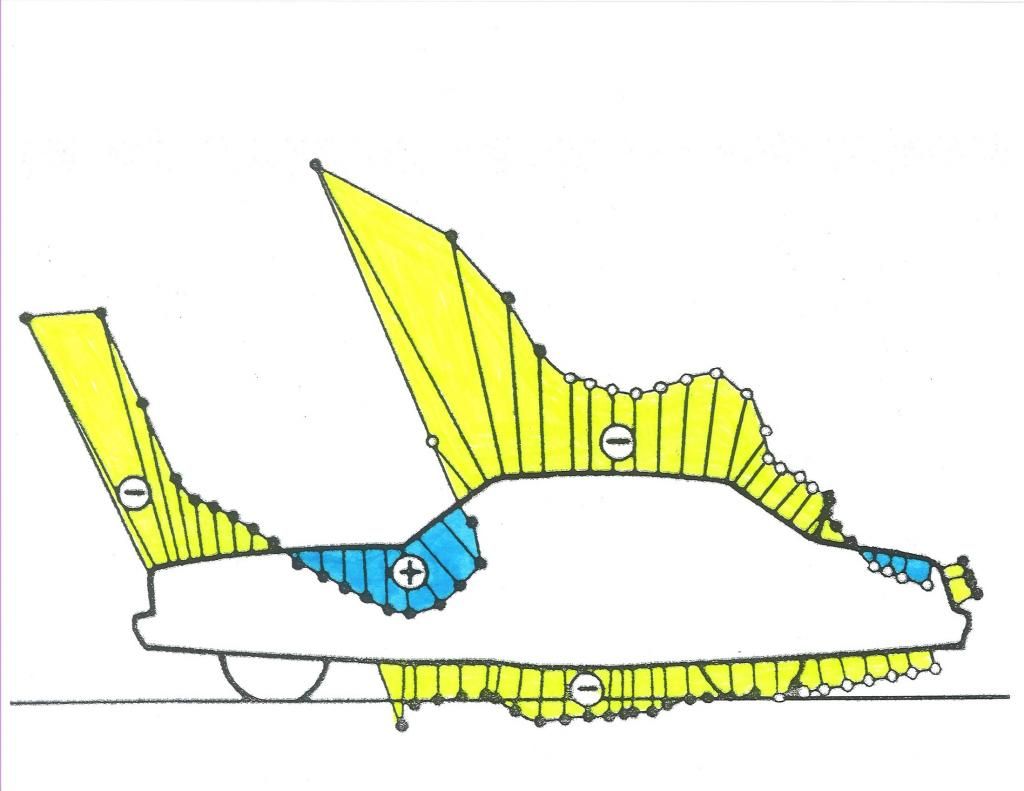
This third image is from the same paper,and they've added a taller spoiler which while providing more down-force,is adding to the overall drag.
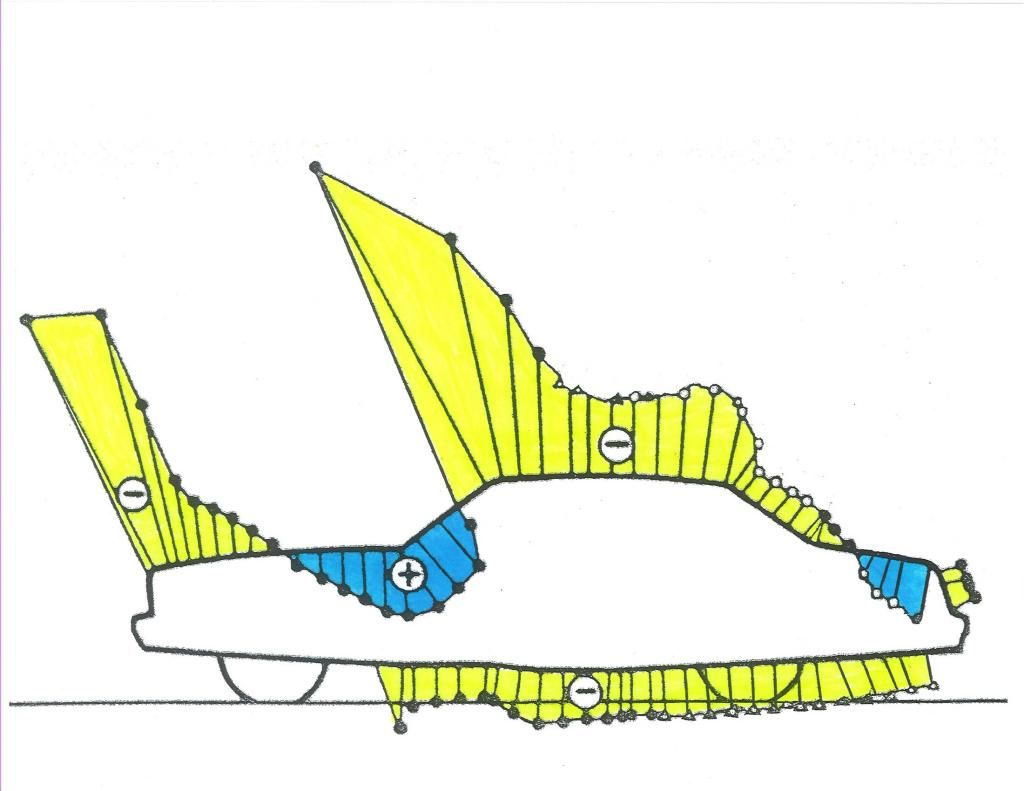
This fourth image is from GM's "Aerodynamics for Body Engineers," by Kent B. Kelly and Harry J. Holcombe, SAE Paper #649A,1963,illustrating the pressure distribution for the 'new' Corvette Stingray.
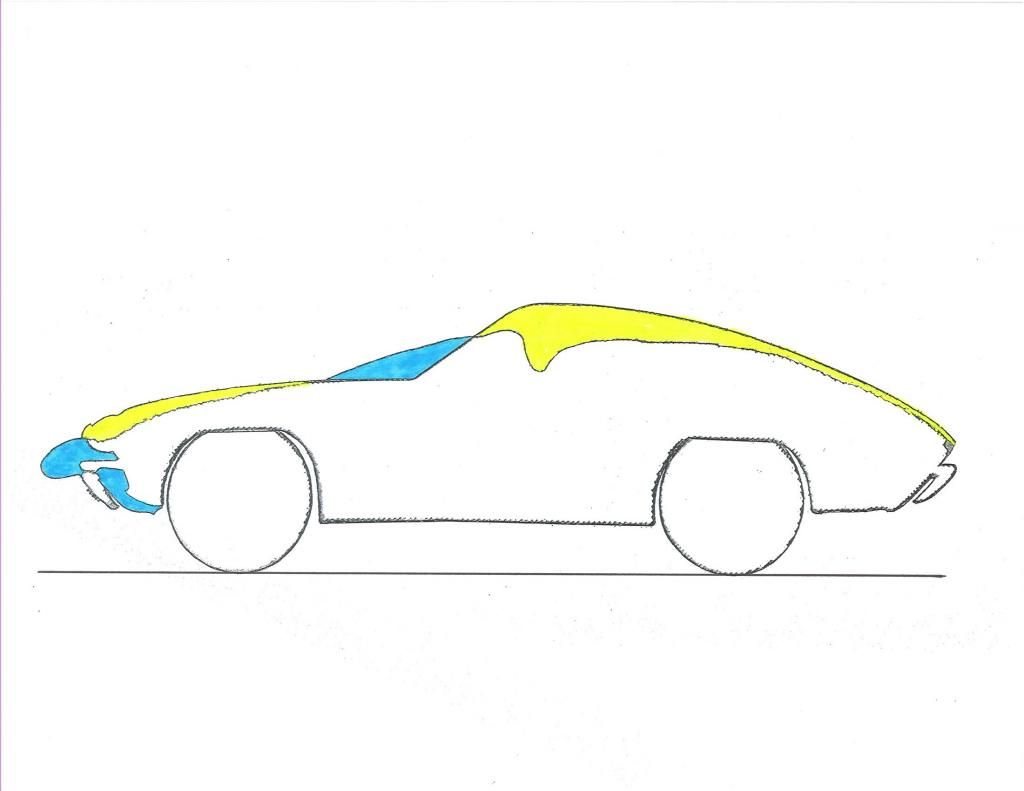
This 5th image is for a Jaray Combination Form car of the 1930s,from Sighard Hoerner's book,"Aerodynamic Drag,Fig.9.4,1951.
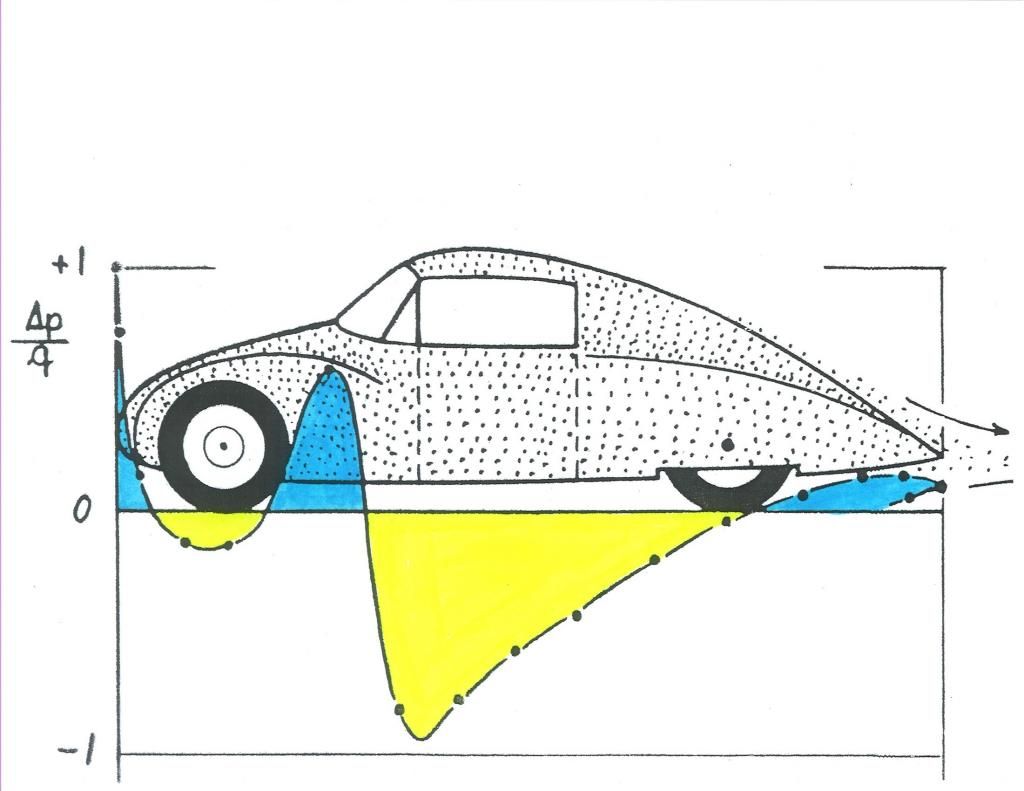
This 6th image is of an 1961 Ferrari 250 GT,from Professor Alberto Morelli and Pininfarina,included in "The Time Tunnel-An Historical Survey of Automotive Aerodynamics",by Karl E. Ludvigsen,Mobility Systems Co.,SAE Paper # 700035,1970.
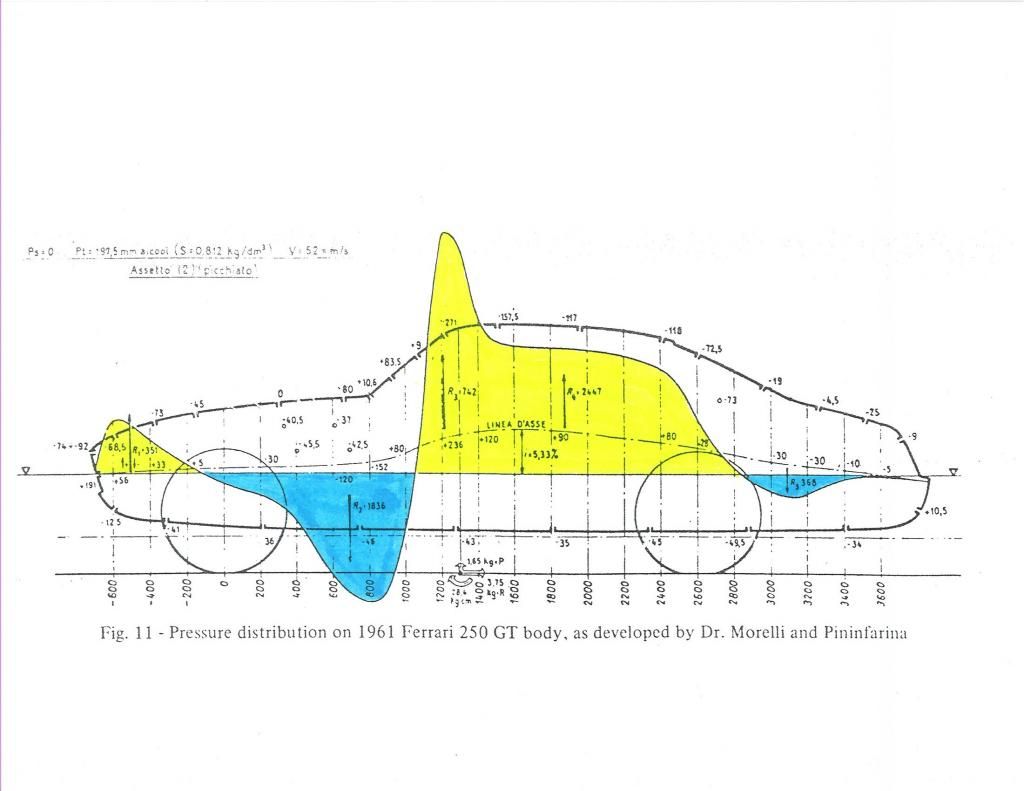
This 7th image is the 'alpha' car from F.K.Schenkel's research,without any front or rear spoiler.
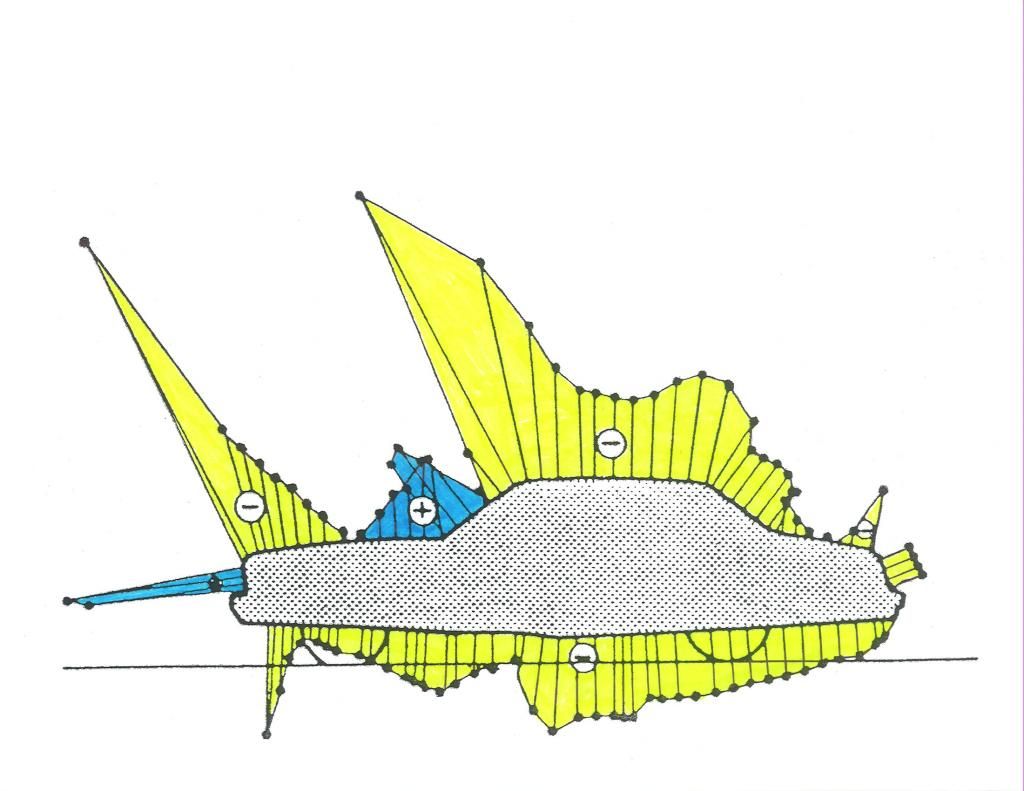
This 8th image is adapted from Hucho's 2nd Edition book,Fig.6.8.I've un-nested the 1965 Volkswagen 1600 Sedan from the 3-vehicle graph to isolate it as an individual table,adding an oversize image of my own of the car.

This 9th image is also an adaptation from Fig.6.8,un-nesting the 1968-74 Volkswagen Transporter from the 3-vehicle table,and adding my own oversize vehicle image.

This 10th image is again,also from the Fig.6.8,isolated,with my larger Porsche 914 Coupe image.

Here,with the Z-car,you can see the streamline contraction near the roof peak which would indicate the high velocity/low pressure.
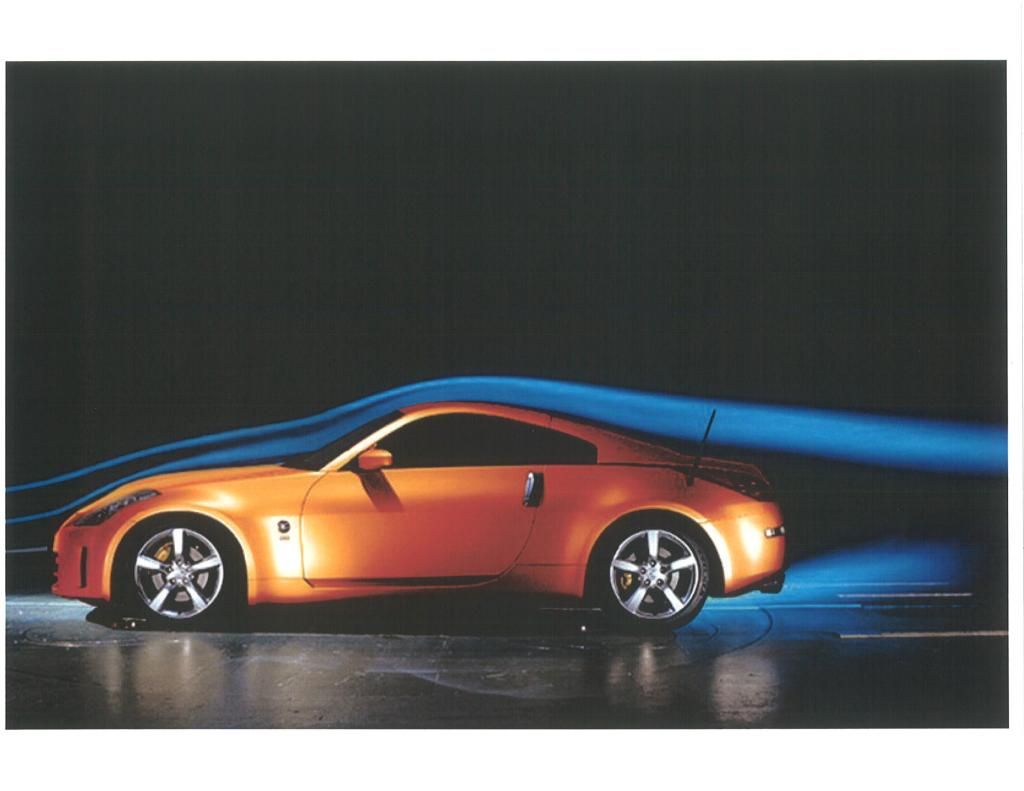
Here you can see the separation line on the Volkshart Saggitta where the contour is too steep
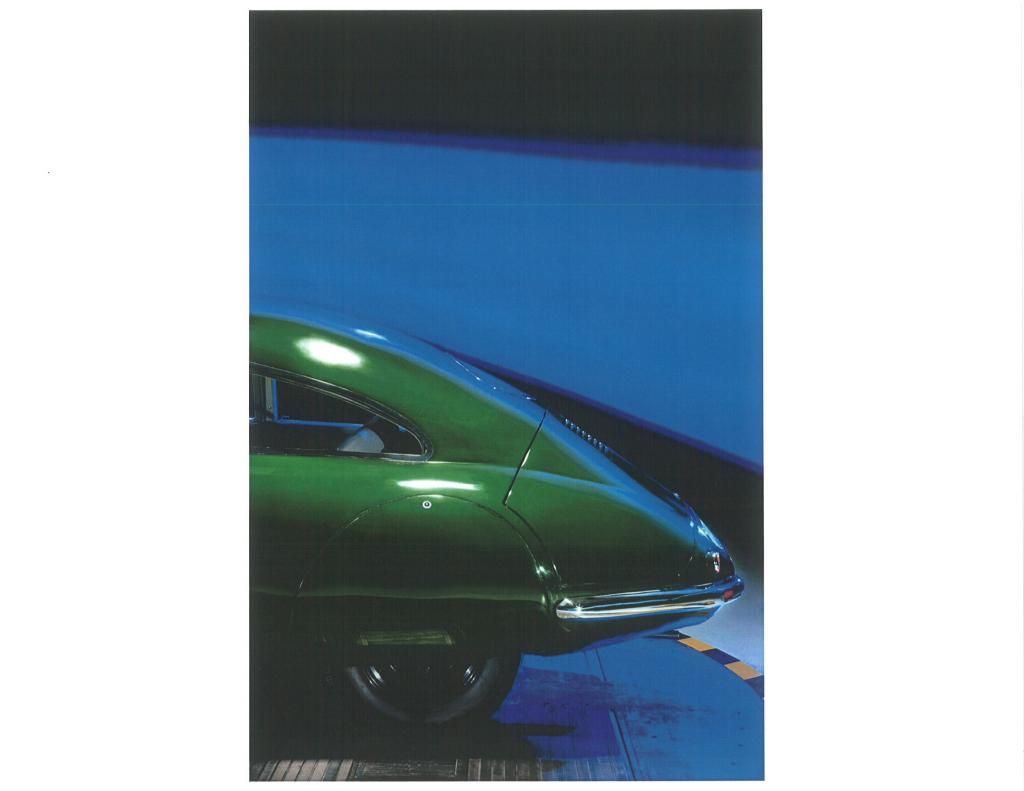
The VW XL1 has a relaxed contour which allows the continuous kinetic transfer into the boundary layer.

VW's 1981 long-tail Flow body walks a fine line and comes in as a simple body with Cd 0.14

Paul Jaray's 'pumpkin seed' of 1922 set the stage with Cd 0.13 (Inspiration for the 'Template').
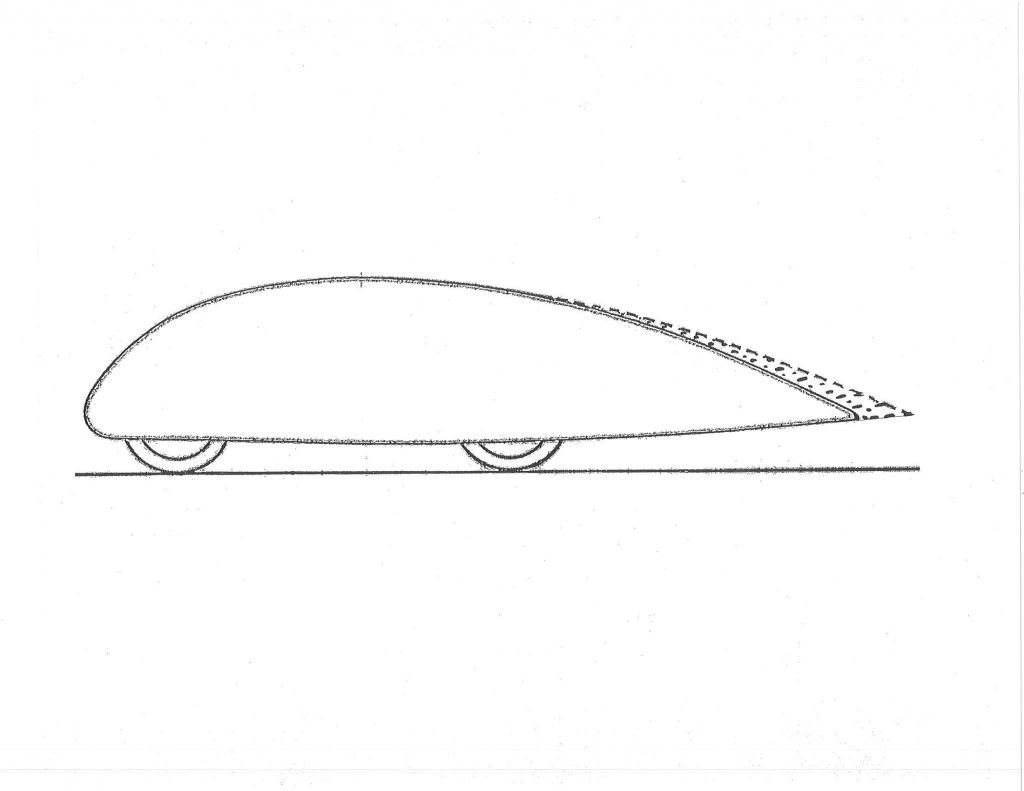
__________________
Photobucket album: http://s1271.photobucket.com/albums/jj622/aerohead2/
Last edited by aerohead; 12-29-2014 at 05:20 PM..
Reason: data correction
|
|
|

|
|
The Following 8 Users Say Thank You to aerohead For This Useful Post:
|
|
 Today Today
|
|
|
|
 Other popular topics in this forum...
Other popular topics in this forum...
|
|
|
|
 12-23-2014, 06:36 PM
12-23-2014, 06:36 PM
|
#2 (permalink)
|
|
herp derp Apprentice
Join Date: Oct 2008
Location: Lawrence, KS
Posts: 1,049
Thanks: 43
Thanked 331 Times in 233 Posts
|
can you dumb this down more for me, or would that pretty much be a book?
feelin kinda like homer....
Dr. Julius Hibbert: Homer, I'm afraid you'll have to undergo a coronary bypass operation.
Homer Simpson: Say it in English, Doc!
Dr. Julius Hibbert: You're going to need open-heart surgery.
Homer Simpson: Spare me your medical mumbo jumbo!
Dr. Julius Hibbert: We're going to cut you open and tinker with your ticker.
Homer Simpson: Could you dumb it down a shade?
Last edited by 2000mc; 12-23-2014 at 06:42 PM..
|
|
|

|
|
The Following 2 Users Say Thank You to 2000mc For This Useful Post:
|
|
 12-23-2014, 07:53 PM
12-23-2014, 07:53 PM
|
#3 (permalink)
|
|
Master EcoModder
Join Date: Aug 2012
Location: northwest of normal
Posts: 29,362
Thanks: 8,352
Thanked 9,118 Times in 7,528 Posts
|
Is it fair to say that molecules, in addition to moving normal to the direction of travel, also get sucked forward and back in the direction of travel?
Renormalizing all that in my head is tough. Could you edit the post and number the illustrations for reference purposes? In fact here's a test:
  
Yes you can. Just place each IMG separated by a Return, Go Advanced and wrap the whole block with Ordered List. Voila!
Thanks for including the Notchback.  Here's mine:
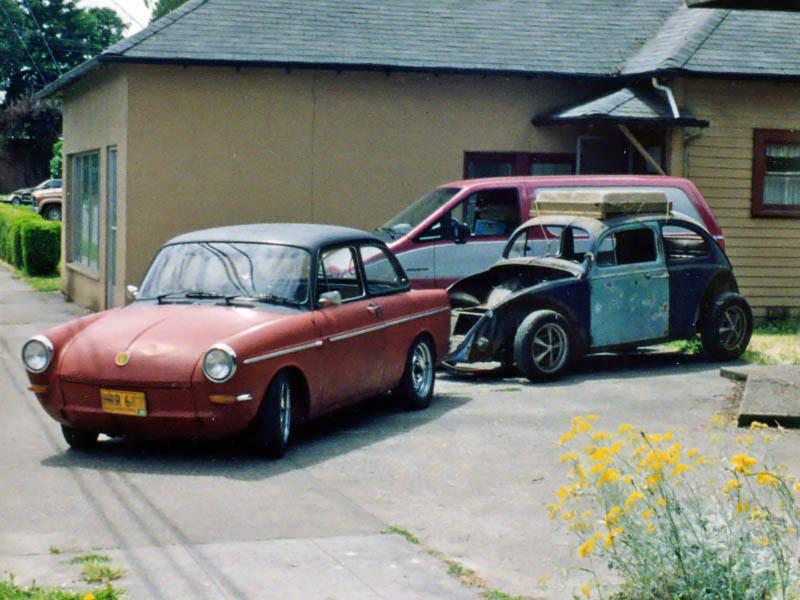
You can almost make out the Reggae/Deadhead sticker on the hood. |
|
|

|
|
The Following User Says Thank You to freebeard For This Useful Post:
|
|
 12-24-2014, 03:18 PM
12-24-2014, 03:18 PM
|
#4 (permalink)
|
|
Master EcoModder
Join Date: Jan 2008
Location: Sanger,Texas,U.S.A.
Posts: 16,514
Thanks: 24,517
Thanked 7,436 Times in 4,817 Posts
|
dumb down
Quote:
Originally Posted by 2000mc

can you dumb this down more for me, or would that pretty much be a book?
feelin kinda like homer....
Dr. Julius Hibbert: Homer, I'm afraid you'll have to undergo a coronary bypass operation.
Homer Simpson: Say it in English, Doc!
Dr. Julius Hibbert: You're going to need open-heart surgery.
Homer Simpson: Spare me your medical mumbo jumbo!
Dr. Julius Hibbert: We're going to cut you open and tinker with your ticker.
Homer Simpson: Could you dumb it down a shade?
|
*It's not a book,but at least a chapter
*The streamline filaments we visualize with smoke all have the same amount of energy,either as potential energy or kinetic energy,or some combination of both.They are isoenergetic.
*Danial Bernoulli demonstrated that when we move air,it loses some of it's static pressure and gains velocity pressure.
*At the forward stagnation point on your car,the pressure acting on this point is the ambient barometric pressure of the atmosphere plus the dynamic pressure.The 'Total' pressure.
*The Dynamic Pressure is in the Drag Power formula,and is ( 1/2 rho V-squared ).
*Near the windshield area,the air is going as fast as it's going to go and has virtually zero static pressure,and all velocity pressure (which an airspeed indicator,manometer,or MAGNEHELIC would operate on).
*With the tables shown,the aerodynamicists have drilled holes down the centerline of a full-scale automobile mockup,installed specially shaped static pressure taps under each hole,which lead off through plastic tubing to a bank of manometers.
*At a given air velocity,the bank of manometers are photographed simultaneously,and the readings captured.
*The length of the distance away from ,or underneath the surface of the car indicates the amplitude of the pressure,whether positive or negative,based upon the Dynamic Pressure.
*Each reading indicates the pressure coefficient at that location.

*The blue spike leading out from the front grille indicates the pressure which rams air through the cooling system,AC condenser,intercooler,and fluid coolers.
*The yellow areas indicate negative pressures measured at the body surface at the sampling locations.
*On this particular car,you notice that beyond the hood/cowl/windscreen bottom,there's no positive pressure acting on the body.
*This car would have 'lift' issues,front and rear,easily remedied with an airdam and small rear spoiler.
--------------------------------------------------------------------------
*For streamlining,you want gentle teardrop taper which while providing a small pressure rise,does not exceed what the turbulent boundary layer can handle.
*The air directly against the skin of your car is already at a standstill,do to the viscous affects of the air.
*If the body cross-section changes too rapidly,Bernoulli's Theorem mandates that the air decelerate.
*This is impossible,since the air is already at rest.
*And since the angle is too steep,the free-stream outside the boundary layer cannot successfully transfer momentum energy (bullets) to pin the air against the body,the boundary layer just lifts away,and heads for the windshield area,while being smacked by the oncoming flow,causing it to roll up into eddies,then turbulence.
*Here is the 1963 Corvette Stingray.With a 'Template' comparison we can anticipate rear lift issues,and with the pressure profile you can see that there exists no positive pressure over the back of the car.

If you fast-forward to 2014,you can see how GM has lofted the aft-body of the Corvette Stingray,adding high-speed stability in the bargain.
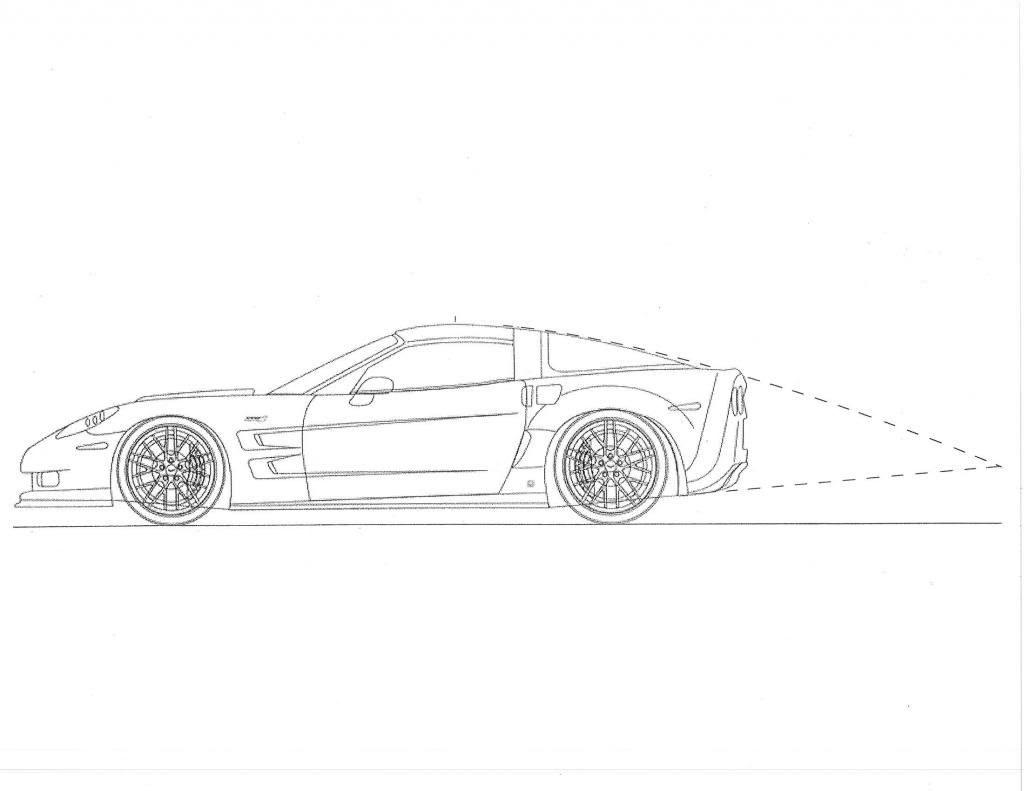
*They get some mpg potential as well.
__________________
Photobucket album: http://s1271.photobucket.com/albums/jj622/aerohead2/
|
|
|

|
|
The Following 2 Users Say Thank You to aerohead For This Useful Post:
|
|
 12-24-2014, 06:22 PM
12-24-2014, 06:22 PM
|
#5 (permalink)
|
|
Master EcoModder
Join Date: Dec 2008
Location: Southern WI
Posts: 829
Thanks: 101
Thanked 563 Times in 191 Posts
|
Quote:
Originally Posted by aerohead

.....This is one of the most important things to know as an aero-modder.
--------------------------------------------------------------------------
All the air around your vehicle wants to flow to this area of lowest pressure!
Let me repeat that.
All the air around your vehicle wants to flow to the area around your windshield header!
-------------------------------------------------------------------------
......
|
Hi Phil,
I read through this particular post several times, and have to mention something.
When you said, "All the air around your vehicle wants to flow to the area around your windshield header!", I have a simple comment.
I work in a Flow Lab, and have worked with sonic nozzles and subsonic orifices for many years.
Theory:
Any time one wants to get air molecules to move, a differential pressure (dP) is required.
In this graphic, the molecular flow is from left to right, and
- P1 is inlet pressure (usually gage + baro)
- P2 is throat pressure (or lack of, and can be vacuum)
-- an extremely high vacuum for sonic nozzles
-- can be close to 28 inHg vacuum or higher
- P3 is exhaust pressure (typically at baro or ambient)

Sonic nozzles are typically used for controlling bulk or mass flow, depending on the application. We use them to calibrate mass flow meters in the Lab.
The only reason that flow transfers from P1 past P2, to P3 is dP or delta pressure. The flow at the throat (P2) can be almost 100% kinetic energy, with no pressure component, and P1 and P3 are mostly potential energy, with no kinetic.
When it is stated that the air molecules "want" to move from P1 to P2 due to the low pressure there, then why would the flow at P2 want to progress towards P3? Location P3 is at higher pressure, and based on your observation, P3 flow would want to reverse and flow towards P2.
This does not happen is life so another mechanism causes the general flow from P1 past P2 to P3. It is dP or delta pressure that causes generalized flow across any flow device, be it a flow orifice, nozzle, or any other flow restrictor.
Summing up, I would say that any dP around our vehicle moving down the road causes a generalize flow around the vehicle. The pressure at the front of the vehicle has to be higher at the front, than at the rear for the dP to be enough to cause flow around the object.
Phil, thanks for all the nice graphics in your post.
Jim.
Last edited by 3-Wheeler; 12-24-2014 at 07:15 PM..
|
|
|

|
|
The Following 3 Users Say Thank You to 3-Wheeler For This Useful Post:
|
|
 12-24-2014, 07:35 PM
12-24-2014, 07:35 PM
|
#6 (permalink)
|
|
Master EcoModder
Join Date: Aug 2012
Location: northwest of normal
Posts: 29,362
Thanks: 8,352
Thanked 9,118 Times in 7,528 Posts
|
Well, I'd number the pictures for you if I could.  But the one I wanted to point out is the one you used as an example. 
By way of your explanation—the discontinuities around the bumpers would be due to lack of sensor data.
Do you think the abstraction where they have the pressure radiating normal to the surface, or the one with a single straight line is less misleading? |
|
|

|
 12-29-2014, 01:15 PM
12-29-2014, 01:15 PM
|
#7 (permalink)
|
|
Master EcoModder
Join Date: Jan 2008
Location: Sanger,Texas,U.S.A.
Posts: 16,514
Thanks: 24,517
Thanked 7,436 Times in 4,817 Posts
|
molecules/numbering
Quote:
Originally Posted by freebeard

Is it fair to say that molecules, in addition to moving normal to the direction of travel, also get sucked forward and back in the direction of travel?
Renormalizing all that in my head is tough. Could you edit the post and number the illustrations for reference purposes? In fact here's a test:
  
Yes you can. Just place each IMG separated by a Return, Go Advanced and wrap the whole block with Ordered List. Voila!
Thanks for including the Notchback.  Here's mine:

You can almost make out the Reggae/Deadhead sticker on the hood. |
I've gone back in an numbered the early images,with source credits.Hope that helps.
And yes,the air can move in all directions,including sideways (transverse contamination),depending on pressures and their location on the body.
Post-1985 cars,with body camber,typically have the boundary layer held against the body by a favorable pressure gradient created by the attacking 'source' flow,right up to the position of maximum cross-section.
It's in the aft-body where we are cautioned,as here,we are in an unfavorable pressure gradient,and any 'fast' contour, would create too fast of a pressure rise, overwhelming the turbulent boundary layers ability to receive momentum energy from 'above.'
__________________
Photobucket album: http://s1271.photobucket.com/albums/jj622/aerohead2/
|
|
|

|
|
The Following User Says Thank You to aerohead For This Useful Post:
|
|
 12-29-2014, 02:09 PM
12-29-2014, 02:09 PM
|
#8 (permalink)
|
|
Master EcoModder
Join Date: Jan 2008
Location: Sanger,Texas,U.S.A.
Posts: 16,514
Thanks: 24,517
Thanked 7,436 Times in 4,817 Posts
|
P2
Quote:
Originally Posted by 3-Wheeler

Hi Phil,
I read through this particular post several times, and have to mention something.
When you said, "All the air around your vehicle wants to flow to the area around your windshield header!", I have a simple comment.
I work in a Flow Lab, and have worked with sonic nozzles and subsonic orifices for many years.
Theory:
Any time one wants to get air molecules to move, a differential pressure (dP) is required.
In this graphic, the molecular flow is from left to right, and
- P1 is inlet pressure (usually gage + baro)
- P2 is throat pressure (or lack of, and can be vacuum)
-- an extremely high vacuum for sonic nozzles
-- can be close to 28 inHg vacuum or higher
- P3 is exhaust pressure (typically at baro or ambient)

Sonic nozzles are typically used for controlling bulk or mass flow, depending on the application. We use them to calibrate mass flow meters in the Lab.
The only reason that flow transfers from P1 past P2, to P3 is dP or delta pressure. The flow at the throat (P2) can be almost 100% kinetic energy, with no pressure component, and P1 and P3 are mostly potential energy, with no kinetic.
When it is stated that the air molecules "want" to move from P1 to P2 due to the low pressure there, then why would the flow at P2 want to progress towards P3? Location P3 is at higher pressure, and based on your observation, P3 flow would want to reverse and flow towards P2.
This does not happen is life so another mechanism causes the general flow from P1 past P2 to P3. It is dP or delta pressure that causes generalized flow across any flow device, be it a flow orifice, nozzle, or any other flow restrictor.
Summing up, I would say that any dP around our vehicle moving down the road causes a generalize flow around the vehicle. The pressure at the front of the vehicle has to be higher at the front, than at the rear for the dP to be enough to cause flow around the object.
Phil, thanks for all the nice graphics in your post.
Jim. |
Thanks Jim.
With respect to these automotive pressure histories,we're encouraged to focus on boundary layer phenomena.

*In this 1st wind tunnel photo of spheres,we see the non-dimpled flow separation before the max camber position on a smooth,laminar boundary layer golf ball.The air from the back of the ball is traveling against the flow towards the high-velocity/low-pressure 'windshield area' of the golf ball,triggering separation and high drag.
*In the second image,we've dimpled the ball (driven our car beyond 20-mph) and the inviscid laminar outer flow field is transferring momentum energy into the Reynolds number-induced turbulent boundary layer,allowing flow attachment back to 4-seconds after 12:00 on 'top',and 4-seconds before 6:00 on 'bottom.'
*If you measure the local tangent angle at the separation point you get 22-degrees.
-------------------------------------------------------------------------
*All the air around the sphere still wants to flow to the original laminar boundary layer separation line,but it is prevented by the momentum interchange into the turbulent boundary layer AS LONG AS the body doesn't reach a 'fast' contour (pseudo-fastback).
-------------------------------------------------------------------------
*The yellow spike at the windshield top in all the pressure tables is a reminder of where this 'low' exists on the car,and if we compromise the shape of the car,this is where the air in the turbulent boundary layer is going to attempt to get to.
*If we keep increasing the radius of the aft-body contour,we eventually reach a crude streamline body of revolution,and the wake is eliminated.
*This is what Hucho's books are all about,and underlies all automotive streamlining.
--------------------------------------------------------------------------
*In your wind tunnel,the air mover,or vacuum vessel which drives the supersonic flow,is powering the delta-P which enables the flow.Work is added to the system just as the brake horsepower of the cars engine.
*The wind tunnel is also a closed system and you have conservation of air mass volume.
*Whatever passes P1 must equal P2 and P3,by definition.
*The total energy of any given imaginary streamline filament will be equal to any other streamline element under steady-state conditions.
*This is the isoenergetic concept established by Bernoulli.
*P1 is accelerated from a low velocity/high-pressure,to mostly velocity at P2,then decelerated to a lower velocity/higher pressure again at P3.
*This is exactly what Daniel Bernoulli demonstrated.
*You have lost some energy to surface friction and viscous friction.This energy is lost forever (2nd-law of Thermo).
*In your transonic and supersonic work you've got to deal with shockwave losses as well.
--------------------------------------------------------------------------
*Our engine or motor power induces motion.
*Motion displaces the air mass.
*Displacement creates acceleration
*Acceleration creates velocity
*Velocity affects pressure
*The difference between the forward stagnation point and base pressure of the wake is the pressure drag which is the major portion of the total drag,of which streamlining (by definition) attempts to reduce or eliminate.
*If the aft-body is correct,there'll be zero separation,almost total pressure recovery,and the base pressure will be close to that of the forward stagnation point,killing pressure drag.
__________________
Photobucket album: http://s1271.photobucket.com/albums/jj622/aerohead2/
Last edited by aerohead; 12-29-2014 at 02:13 PM..
Reason: spelling
|
|
|

|
|
The Following User Says Thank You to aerohead For This Useful Post:
|
|
 12-29-2014, 02:42 PM
12-29-2014, 02:42 PM
|
#9 (permalink)
|
|
Master EcoModder
Join Date: Jan 2008
Location: Sanger,Texas,U.S.A.
Posts: 16,514
Thanks: 24,517
Thanked 7,436 Times in 4,817 Posts
|
bumpers/abstraction
Quote:
Originally Posted by freebeard

Well, I'd number the pictures for you if I could.  But the one I wanted to point out is the one you used as an example. 
By way of your explanation—the discontinuities around the bumpers would be due to lack of sensor data.
Do you think the abstraction where they have the pressure radiating normal to the surface, or the one with a single straight line is less misleading? |
Schenkel didn't seem to get into the bumpers per se

Morelli took some measurements although they're handled individually.

Here's a 1959 Chevy Bel Air,and it looks like GM investigated the bumper regions

Here's their 1960 Corvair Coupe
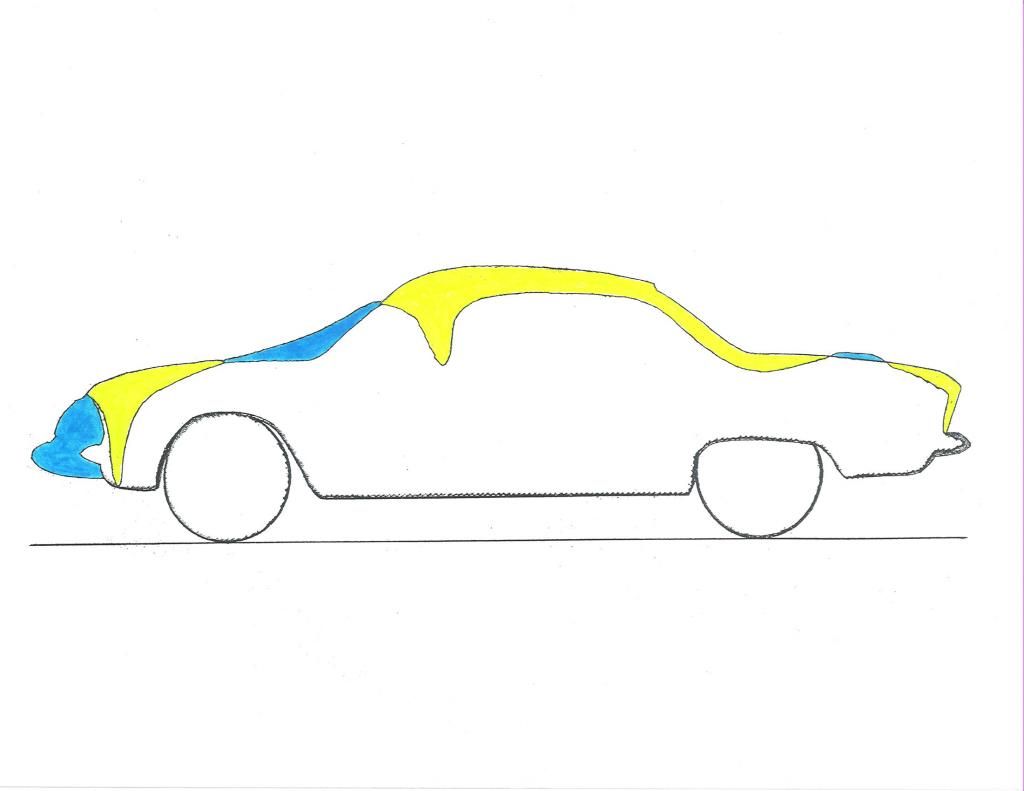
*Since the bumpers of the day were not integrated into the body,they'd be essentially 2-dimensional themselves and the investigators might have just blown them off.
-------------------------------------------------------------------------
As to the pressure representations,the length of the elements depict the amplitude of the pressure as a function of the dynamic pressure.
*At 60-mph,the forward stagnation point would essentially be the dynamic pressure.
*The direction of each element would reflect the resultant force direction of the pressure acting on the surface boundary of the body.
*The 'LONG' yellow spike at the windshield indicates that the velocity of the highly accelerated local flow, exceeds the 'road speed' of the air.Flow over a roof might be 1-1/2 X the velocity of the uninterrupted flow.Same for the A-pillars.
__________________
Photobucket album: http://s1271.photobucket.com/albums/jj622/aerohead2/
|
|
|

|
 03-11-2016, 08:35 AM
03-11-2016, 08:35 AM
|
#10 (permalink)
|
|
Master EcoModder
Join Date: Jul 2011
Location: Ann Arbor, Michigan
Posts: 4,211
Thanks: 141
Thanked 2,825 Times in 1,982 Posts
|
Nice thread, sort of wish there were extreme examples such as the Aero-Template car and a Pick-Up Truck for comparison.
Is it accurate or ignorant to say/think that avoiding large negative pressures will in turn avoid producing large positive pressures?
That is to say, if you never accelerate the air to begin with, it will not have to slow down later to equalize the mass air flow (correct term?).
EDIT:
The so-called perfect shape would have quite a bit of lift, perhaps we should turn this thing upside down?
https://surjeetyadav.wordpress.com/author/surjeetyadav/


Nice little paper on down-force without wings:
https://lucky13racing.wordpress.com/
__________________
George
Architect, Artist and Designer of Objects
2012 Infiniti G37X Coupe
1977 Porsche 911s Targa
1998 Chevy S-10 Pick-Up truck
1989 Scat II HP Hovercraft
You cannot sell aerodynamics in a can............
Last edited by kach22i; 03-11-2016 at 09:11 AM..
|
|
|

|
|
The Following 2 Users Say Thank You to kach22i For This Useful Post:
|
|
|